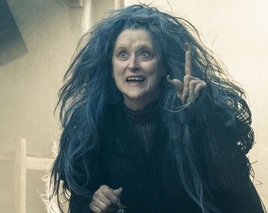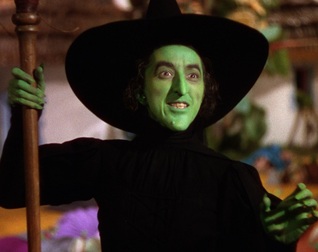
Meryl Streep, I fear for your legacy.
Yes I know, you just got the Presidential Medal of Freedom. Along with your three Oscars. And a heap of new nominations for your performance as The Witch in “Into the Woods,” which opens Christmas Day. But I am deeply concerned about your place in posterity.
You see, we are hatching a generation of young moviegoers whose first exposure to your protean talents will be in “Into the Woods”—and they will be forever scarred, incapable of watching your other performances without a shiver of unconscious dread. As the erratic sorceress who locks up her daughter into a tower out of possessive motherly love, then blinds her prince, and otherwise performs despicable (if often funny) acts of magical barbarism against the humans around her, your Witch is certainly a villainess for the ages…just not the pre-teen ages. Children will listen… and be traumatized.
Yes I know, you just got the Presidential Medal of Freedom. Along with your three Oscars. And a heap of new nominations for your performance as The Witch in “Into the Woods,” which opens Christmas Day. But I am deeply concerned about your place in posterity.
You see, we are hatching a generation of young moviegoers whose first exposure to your protean talents will be in “Into the Woods”—and they will be forever scarred, incapable of watching your other performances without a shiver of unconscious dread. As the erratic sorceress who locks up her daughter into a tower out of possessive motherly love, then blinds her prince, and otherwise performs despicable (if often funny) acts of magical barbarism against the humans around her, your Witch is certainly a villainess for the ages…just not the pre-teen ages. Children will listen… and be traumatized.
A Curse on Madame Armfeldt

OK, Meryl’s legacy is probably secure, but I speak my concern from experience. As youngsters growing up in San Francisco, my sister and I, in a precocious act of sophistication, bought tickets to see the Broadway touring company of Stephen Sondheim’s romantic “A Little Night Music” at the Curran Theatre. What should have been my joyful introduction to the delights of Sondheim was instead a waking nightmare: the role of Madame Armfeldt was played by Margaret Hamilton—the Wicked Witch of the West in “The Wizard of Oz” film. Her cackling evil was seared on my young brain, and the Sondheim musical was ruined. Meanwhile poor Margaret Hamilton, a fine actress, never escaped that terrifying legacy for generations of American children. (You can see her on YouTube touchingly trying to reverse that curse in a 1975 episode of “Mr. Rogers’ Neighborhood.”)
Even so, I am grateful that my parents exposed us as tots to “The Wizard of Oz,” in all of its upsetting splendor—children have resilient, if impressionable, imaginations. But “Into the Woods” presents a more challenging decision for parents, because at heart (despite interweaving the tales of such childhood favorites as Little Red Riding Hood, Cinderella and Jack and the Beanstalk, and despite the Disney brand) the film is a dark and very adult journey. It explores the unintended and sometimes tragic consequences of our quest for “happily every after.” As one lyric puts it, “wishes come true, not free.” Promises are broken; the land is beset by violence; beloved characters die.
Sondheim and his collaborator James Lapine never intended to make a children’s musical; in fact, most school performances present only the first, more cheerful act, a truncated version called “Into the Woods Jr.” But unless you’re willing to leave your movie seat halfway through these “Woods,” that’s really not an option with the film. Nor would I want it to be.
The power of the musical, which I have seen in many incarnations since its 1987 Broadway premiere, is that it deals, like its fairy-tale source material, in archetypes. Stories of absent fathers, dead mothers, far-off princes, dark woods and dangerous wolves play out deep-seated fantasies (and nightmares) about abandonment, poverty, sexual awakening.
And then there are the giants.
The destruction wrought by an enraged, provoked lady giant stomping through the land is a terrifying Rorschach test. Each time I see the show, my response to the giant is different, correlating with my own fears and the preoccupations of the times. In 1987, it was hard not to connect the wanton death unleashed by the giant with the ongoing devastation of AIDS (and indeed, one of the show’s tender closing songs, “No One Is Alone,” became in the 1990s something of an AIDS anthem in the gay community—a call to compassion and collective responsibility).
Successive viewings have morphed my projections onto the giant into other deeply resonant threats: nuclear destruction, environmental despoliation, even the intractable tragedy of the Israeli-Palestinian conflict (this during a production at the Oregon Shakespeare Festival I saw in August, at the height of the Gaza war). Such is the power of archetypes—they accommodate time and circumstance, retaining their potency.
Film is a far more literal medium than theater, so I wonder if the viscerally realistic giant of Rob Marshall’s film (played with gusto by the formidable, if digitally enhanced, British actress Frances de la Tour) will invite movie audiences of the future to project their own fears onto her, too. I hope so—“Into the Woods,” like “The Wizard of Oz,” deserves to remain a classic—though perhaps more for adults than children. That will require a certain elasticity in the way we interpret its characters...an ability to see ourselves, no matter which Witch we watch.
A version of this article first appeared in the San Francisco Chronicle on Dec. 17, 2014.
Even so, I am grateful that my parents exposed us as tots to “The Wizard of Oz,” in all of its upsetting splendor—children have resilient, if impressionable, imaginations. But “Into the Woods” presents a more challenging decision for parents, because at heart (despite interweaving the tales of such childhood favorites as Little Red Riding Hood, Cinderella and Jack and the Beanstalk, and despite the Disney brand) the film is a dark and very adult journey. It explores the unintended and sometimes tragic consequences of our quest for “happily every after.” As one lyric puts it, “wishes come true, not free.” Promises are broken; the land is beset by violence; beloved characters die.
Sondheim and his collaborator James Lapine never intended to make a children’s musical; in fact, most school performances present only the first, more cheerful act, a truncated version called “Into the Woods Jr.” But unless you’re willing to leave your movie seat halfway through these “Woods,” that’s really not an option with the film. Nor would I want it to be.
The power of the musical, which I have seen in many incarnations since its 1987 Broadway premiere, is that it deals, like its fairy-tale source material, in archetypes. Stories of absent fathers, dead mothers, far-off princes, dark woods and dangerous wolves play out deep-seated fantasies (and nightmares) about abandonment, poverty, sexual awakening.
And then there are the giants.
The destruction wrought by an enraged, provoked lady giant stomping through the land is a terrifying Rorschach test. Each time I see the show, my response to the giant is different, correlating with my own fears and the preoccupations of the times. In 1987, it was hard not to connect the wanton death unleashed by the giant with the ongoing devastation of AIDS (and indeed, one of the show’s tender closing songs, “No One Is Alone,” became in the 1990s something of an AIDS anthem in the gay community—a call to compassion and collective responsibility).
Successive viewings have morphed my projections onto the giant into other deeply resonant threats: nuclear destruction, environmental despoliation, even the intractable tragedy of the Israeli-Palestinian conflict (this during a production at the Oregon Shakespeare Festival I saw in August, at the height of the Gaza war). Such is the power of archetypes—they accommodate time and circumstance, retaining their potency.
Film is a far more literal medium than theater, so I wonder if the viscerally realistic giant of Rob Marshall’s film (played with gusto by the formidable, if digitally enhanced, British actress Frances de la Tour) will invite movie audiences of the future to project their own fears onto her, too. I hope so—“Into the Woods,” like “The Wizard of Oz,” deserves to remain a classic—though perhaps more for adults than children. That will require a certain elasticity in the way we interpret its characters...an ability to see ourselves, no matter which Witch we watch.
A version of this article first appeared in the San Francisco Chronicle on Dec. 17, 2014.
 RSS Feed
RSS Feed
